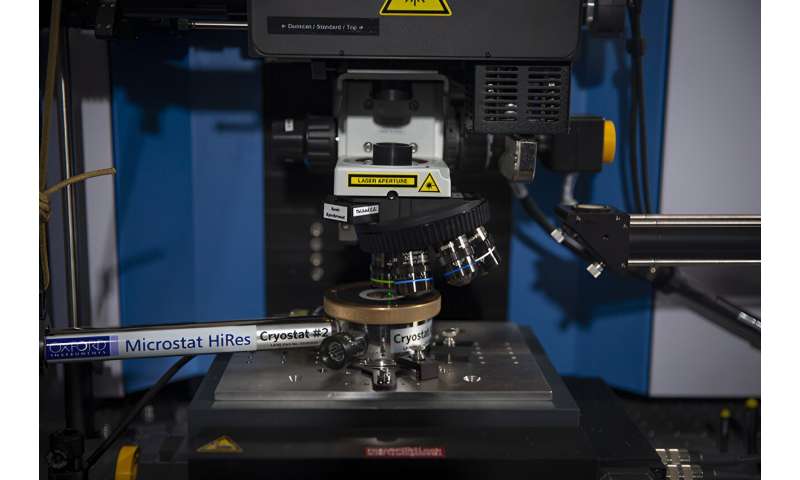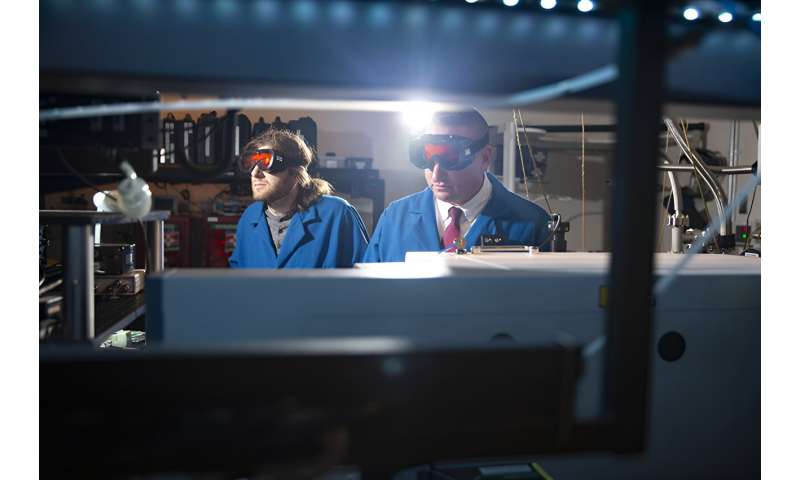New research into topological phases of matter may spur advances in innovative quantum devices. As described in a new paper published in the journal Nature Communications, a research team including Los Alamos National Laboratory scientists used a novel strain engineering approach to convert the material hafnium pentatelluride (HfTe5) to a strong topological insulator phase, increasing its bulk electrical resistance while lowering it at the surface, a key to unlocking its quantum potential.
“I’m excited that our team was able to show that the elusive and much-sought-after topological surface states can be made to become a predominant electrical conduction pathway,” said Michael Pettes, scientist with the Center for Integrated Nanotechnologies (CINT) at the Laboratory.
“This is promising for the development of types of quantum optoelectronic devices, dark matter detectors and topologically protected devices such as quantum computers. And the methodology we demonstrate is compatible for experimentation on other quantum materials.”
Strain engineering approach yields results
At the University of California, Irvine, members of the research team grew the HfTe5 crystals and employed a strain engineering approach—applying mechanical force to the material—at cryogenic temperatures of 1.5 Kelvin, or approximately minus 457 degrees Fahrenheit.
At Pettes’s CINT laboratory in Los Alamos, the samples underwent optical spectroscopy to image the sample at the sub-micron level. CINT researchers then performed angle-resolved photoemission spectroscopy at the University of Tennessee, helping illuminate the effects of the strain engineering.
-

A close-up view of confocal Raman spectroscopy, in which a 532-nanometer laser (seen in green) is being used to probe the vibrational structure of van der Waals materials contained in a high vacuum cryostat at 3.8 Kelvin. Credit: Los Alamos National Laboratory
-

Pettes and Vallin work in their laboratory at CINT. Credit: Los Alamos National Laboratory
The research team realized that the strain engineering changed the behavior of HfTe5, turning it from a weak topological insulator to a strong topological insulator. That is, the material’s bulk electrical resistivity, or resistance to letting electrical current pass through, increased by more than three orders of magnitude.
The material also saw its topological surface states dominate the electronic transport. Those properties could make HfTe5 well-suited for quantum devices. The promising results also bode well for extending the strain engineering approach to the study of topological phase transitions in van der Waals materials and heterostructures, lattice-like structures characterized by a strong in-plane bond and a weak out-of-plane bond among the atoms or molecules, like the pages in a book.
When studied with a high magnetic field, the newly discovered topological property may help uncover phenomena related to exotic physics such as quantum anomalies, the unexplained breaking of symmetry in physics. New experiments being conducted at the Los Alamos National High Magnetic Field Laboratory–Pulsed Field Facility subject HfTe5 to strain under ultra-high magnetic fields up to 65 Tesla.
More information:
Jinyu Liu et al, Controllable strain-driven topological phase transition and dominant surface-state transport in HfTe5, Nature Communications (2024). DOI: 10.1038/s41467-023-44547-7
Citation:
Research reveals quantum topological potential in material (2024, January 22)
retrieved 22 January 2024
from
This document is subject to copyright. Apart from any fair dealing for the purpose of private study or research, no
part may be reproduced without the written permission. The content is provided for information purposes only.

